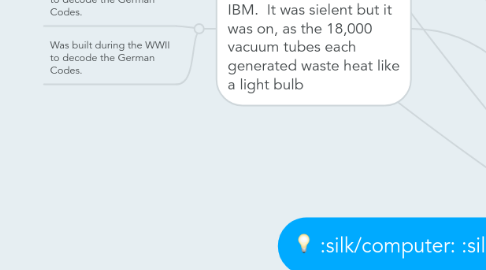
1. Logarithms(AKA. Napier's Bones)
1.1. Allowed multiplication to be performed through addition
2. A gear-driven, one-function calculator which could only add and wasn't very accurate.
3. First Computer that wasn't used to make calculations for humans and just sped up the mill work, But later the punched card idea was used to do much more.
4. This device was as large as a house and powered by 6 steam engines,
5. First Machine to store data as a charge on a capacitor, which is how today's computers store information in their main memory. It is the first fully electric but not programmable machine that got built.
6. Analytic Engine
6.1. This device was as large as a house and powered by 6 steam engines,
7. Stepped Reckoner
8. A four-function (addition, subtraction, multiplication, and division) calculator, that had used ten flutes arranged around their circumference in a stair-step fashion instead of having gears.
9. Machanical Calculating Aid
9.1. Abacus
9.1.1. Aided the memory of the humans that performed the calculations.
9.2. Slide Rule
9.2.1. First built in England in 1632, and was still in use in the 1960's by the NASA engineers of the Mercury, Gemini, and Apollo programs.
9.3. Calculating Clock
9.3.1. The first gear-driven calculating machine that was built.
9.4. Pascaline
9.4.1. A gear-driven, one-function calculator which could only add and wasn't very accurate.
9.5. Power Loom and the Punched Cards
9.5.1. It based its weave and which helped to make the design on the fabric in a pattern that was automatically read from punched wooden cards, which were held together in a long row by rope.
9.5.1.1. First Computer that wasn't used to make calculations for humans and just sped up the mill work, But later the punched card idea was used to do much more.
9.6. Difference Engine
9.6.1. This machine was a steam driven calculating machine the size of a room would be able to compute tables of numbers, like logarithm tables, but the device was never completed.
9.7. Analytic Engine
9.7.1. This device was as large as a house and powered by 6 steam engines,
10. A four-function (addition, subtraction, multiplication, and division) calculator, that had used ten flutes arranged around their circumference in a stair-step fashion instead of having gears.
11. A motorized typewriter that could transmit keystrokes to the mainframe and then print the computer's response on its roll of paper.
12. Electrical Computing
12.1. Mark I
12.1.1. The first programmable digital computer made in the United States, but wasn't a purely electronic computer, rather half mechanical.
12.2. Atanasoff-Berry Computer
12.2.1. First Machine to store data as a charge on a capacitor, which is how today's computers store information in their main memory. It is the first fully electric but not programmable machine that got built.
12.3. Electronic Numerical Integrator and Calculator(ENIAC)
12.3.1. It employed paper card readers obtained from IBM. It was sielent but it was on, as the 18,000 vacuum tubes each generated waste heat like a light bulb
12.4. Colossus
12.4.1. Was built during the WWII to decode the German Codes.
12.5. Universal Automatic Computer(UNIVAC)
12.5.1. The first computer to employ magnetic tape.
12.6. Teletype
13. Mark I
13.1. The first programmable digital computer made in the United States, but wasn't a purely electronic computer, rather half mechanical.
14. The first programmable digital computer made in the United States, but wasn't a purely electronic computer, rather half mechanical.
15. Atanasoff-Berry Computer
16. First Machine to store data as a charge on a capacitor, which is how today's computers store information in their main memory. It is the first fully electric but not programmable machine that got built.
17. Electronic Numerical Integrator and Calculator(ENIAC)
17.1. It employed paper card readers obtained from IBM. It was sielent but it was on, as the 18,000 vacuum tubes each generated waste heat like a light bulb
18. It employed paper card readers obtained from IBM. It was sielent but it was on, as the 18,000 vacuum tubes each generated waste heat like a light bulb
18.1. Was built during the WWII to decode the German Codes.
18.2. Was built during the WWII to decode the German Codes.
19. Colossus
20. Universal Automatic Computer(UNIVAC)
20.1. The first computer to employ magnetic tape.
21. The first computer to employ magnetic tape.
22. Teletype
23. Abacus
23.1. Aided the memory of the humans that performed the calculations.
24. Aided the memory of the humans that performed the calculations.
25. Logarithms(AKA. Napier's Bones)
25.1. Allowed multiplication to be performed through addition
26. Allowed multiplication to be performed through addition
26.1. Pascaline
27. Slide Rule
27.1. First built in England in 1632, and was still in use in the 1960's by the NASA engineers of the Mercury, Gemini, and Apollo programs.
28. First built in England in 1632, and was still in use in the 1960's by the NASA engineers of the Mercury, Gemini, and Apollo programs.
28.1. This machine was a steam driven calculating machine the size of a room would be able to compute tables of numbers, like logarithm tables, but the device was never completed.
29. Calculating Clock
29.1. The first gear-driven calculating machine that was built.
30. The first gear-driven calculating machine that was built.
31. A gear-driven, one-function calculator which could only add and wasn't very accurate.
32. Power Loom and the Punched Cards
32.1. It based its weave and which helped to make the design on the fabric in a pattern that was automatically read from punched wooden cards, which were held together in a long row by rope.
32.1.1. First Computer that wasn't used to make calculations for humans and just sped up the mill work, But later the punched card idea was used to do much more.
